#Tamizh culture
Text


This Saturday begins our Culture Circles!! Join us to learn more about different marginalized communities, their customs, their music, their languages, EVERYTHING! And learn how you can support them on their journey to liberation! discord link in bio @bfpnola since tumblr kills links!
—
Other time zones [clock emoji next to each]:
Saturday, Sept. 23rd
⏰ 5 pm MT — Phoenix, Arizona, USA
—
Sunday, Sept. 24th
⏰ 12 am BST — London, United Kingdom
⏰ 4:30 am IST — Mumbai, India
⏰ 8 am JST — Tokyo, Japan
⏰ 9 am AEST — Sydney, Australia
#reaux speaks#resources#bipoc#undescribed#anti capitalism#queer#history#intersectional feminism#tamizh#india#language#linguistics#sami people#norway#norse#south korea#korean#culture#music#art#dance#discord server
30 notes
·
View notes
Text
Pavitr Prabhakar: The Design
Pavitr Prabhakar my beloved!
I love him. I absolutely love Pavitr and everything about him. And the best thing about him, other than his everything, is his design. So let's get to it!
PART 1: THE MASK
He was so cool and such a total sunshine but the most striking aspect was the immaculate design. Huge upgrade on his old model which was pretty much just a normal spider-suit with a white dhoti, which, not gonna lie, was just disappointing and underwhelming. But they went off on Pavitr's design in the movie and everyone's talking about it so let's also talk about it.
First of all,
LOOK AT MY BOY!!!
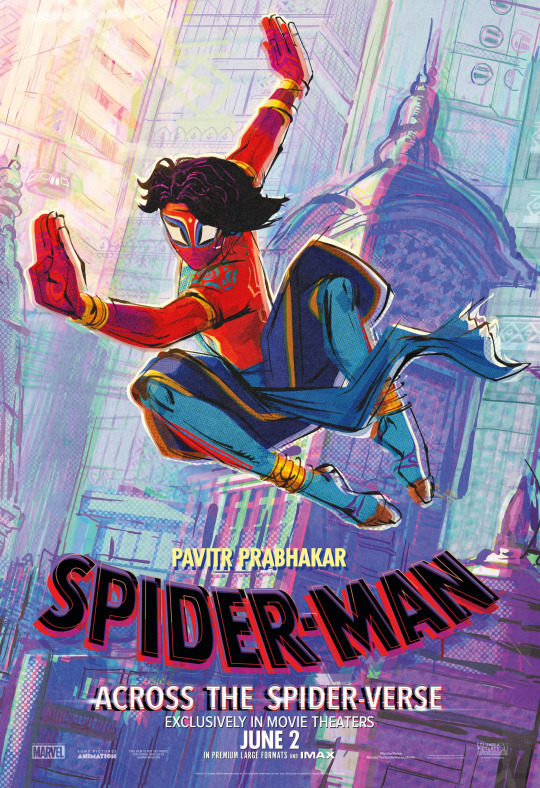
Just look at that design! So cool! So awesome! And so so Desi!!!
Its these desi aspects that I want to shed light on cos I know there are non-Indian fans who didn't catch a lot of the nuances cos they're not familiar enough with Indian culture and even Indian fans who didn't know about some details cos they aren't from the areas the inspiration for these elements were drawn from.
Mainly I hope to help artists and writers with this, so they have more information to create with, as well as the casual fans so they have more info and can immerse themselves better as well as appreciate just how much effort went into making this spectacular movie.
This might be a long post with me just rambling away so braze yourself people.
So lets get into it.
{WARNING: Infodump incoming}
First, lets start with the Mask
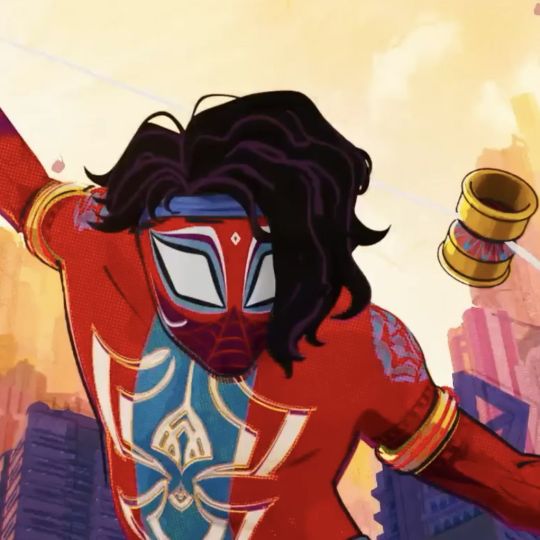
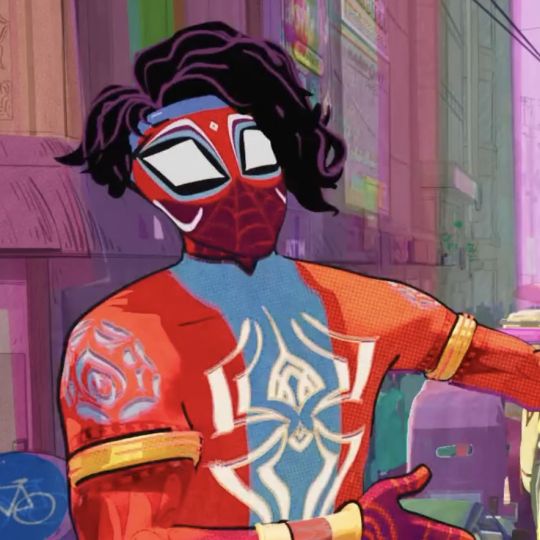
So here we have two different angles of his mask. The most prominent features of his mask are his eyes. There is a multi-layer outline for them in black, blue, red, and white, which of course are the classic spiderman colours but never quite used like this. Usually there is only a single outline in shades of, or adjacent colours of black, red, or white.
(Disclaimer: I'm not a 100% sure of this being actually the inspo behind the eyes. I'm pretty sure though, like 80%. So this has not been confirmed.)
The design for his eyes reminded me of one specific thing:
Koodiyattam, which is a 2000 year old ancient temple artform from the southern Indian state of Kerala. Koodiyattam is not just the only surviving Sanskrit theatre in the world, but it also includes elements of koothu, from the Sangam era, the golden age of Tamizh culture, and thus was declared by UNESCO as a Masterpiece of the Oral and Intangible Heritage of Humanity.
Below is a picture of a Koodiyattam performer.

Instantly you'll realize that this is a costume drama, with extensive makeup, and complicated dress, especially with regards to the headgear, and is overall similar to the Beijing opera, not in terms of make or design or performance, but rather in elaborateness of ensemble. Japanese art forms like Noh or Kabuki could also come to mind along with certain Balinese dances.
Here is another photo which will give you a better look.
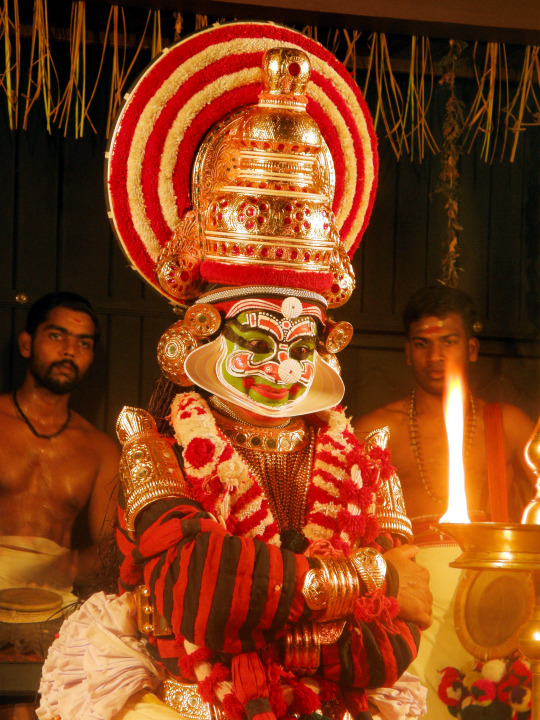
Notice the layered eye makeup in black, red, and white.
Here we have a closeup of a different performer where you can see it even more clearly.

The first time I saw Pavitr's eyes on screen, this is what immediately came to my mind as someone interested in traditional theaters of all kinds. Notice that Koodiyattam extensively uses reds and blacks, along with whites, which is also the colour palette that most spiderpeople choose, which is a cool coincidence. Blue is not that heavily used unlike the others however, but you can see it more in some costumes but generally not in makeup.
If we're talking less of what it reminded me of and more in terms of what the actual inspiration for the eye design probably was, it was most likely Kathakali, Koodiyattam's much younger, more well known, and very popular relative.

As you can see, Kathakali took its cues for costuming from Koodiyattam. (Actually it took its costuming cues from earlier art forms called Krishnattam, and Ramanattam, but they took it from Koodiyattam so it works.)
Again you can see the layered eye makeup, most prominently in black. (Cool fact, the costume and makeup changes according to the characters being portrayed on stage.)
Below is a picture of a Kathakali character with more elaborate eye makeup.
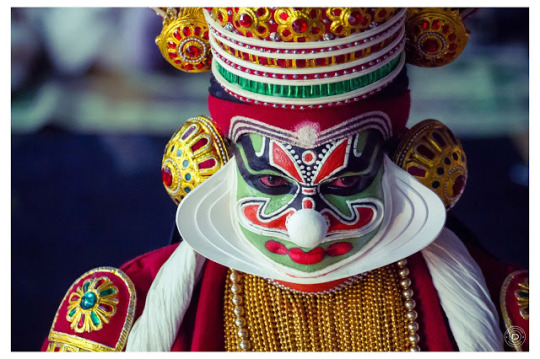
(I know a lot of you might think its the same makeup as Koodiyattam but I promise you its not. Inspired yes, same no.)
Because of the elaborate makeup and costume, expression can be a challenge so the art forms make maximum use of exaggerated body movements, hand signs, dance, lyrics etc. But the crowning element of acting in Koodiyattam and Kathakali are the eye techniques and how much simple eye movements can convey to the audience, which if you think about it, is also the case for spider-people. They're the most expressive superheroes in any medium, but they're fully covered so a lot of their expressiveness, both in comics and animation is conveyed through the shape of the eyes, body language, and speech. Another cool coincidence.
Below is a link to a short video which gives an brief overview of Kathakali and the importance of eyes in its performance.
youtube
This second link is a closeup of the eye movements of a female Kathakali character (women characters are called 'Minukku'). It shows how these highly trained artists can even move their eyes according to music. I have been told this can be uncomfortable to watch for some people so here's a warning for those who find eyeballs discomfiting.
youtube
And finally this one right here is a link to a short video on Koodiyattam.
youtube
{All three of these links are mainly aimed at people who find this sort of stuff interesting and want to check them out so if you're not, you can scroll past it, no big deal!}
(Oh man this is getting way too long and more like me gushing about traditional theatre than spiderman. Sorry about that.)
Now lets get back to our boy Pavitr. The second most noticeable feature of his mask is the curved, white line underneath his eyes, which gives off the impression of tusks. The first two pictures on this post already show the lines quite clearly but I'll attach one more angle.

Something that immediately came to mind when I saw them was Theyyam but I wasn't sure until I saw this post.

This was the same account that talked about how Pavitr's movements are inspired from Kalaripayattu so I was inclined to trust this. And after this one of the animators did confirm this so I was right on the money.
What exactly is Theyyam?
It is an ancient Hindu folk ritual practiced in northern Kerala, predominantly in the North Malabar region. Its origins can be traced back to the neolithic and chalcolithic eras. And unlike Koodiyattam and Kathakali which are associated with temples and the Koothambalam(temple theatre where temple artforms are performed), Theyyam is performed in the open air in Kaavu, the sacred groves of Kerala. The Theyyam performers become channels and vessels for the gods. Connect this to the 'Great Weaver'/ 'Master Weaver' who gave Pavitr his powers.
(Btw, these sacred groves are also ecological treasure troves and one of the ancient ways of nature preservation and they're really cool so check them out if you can.)
Below are two images of different Theyyams.
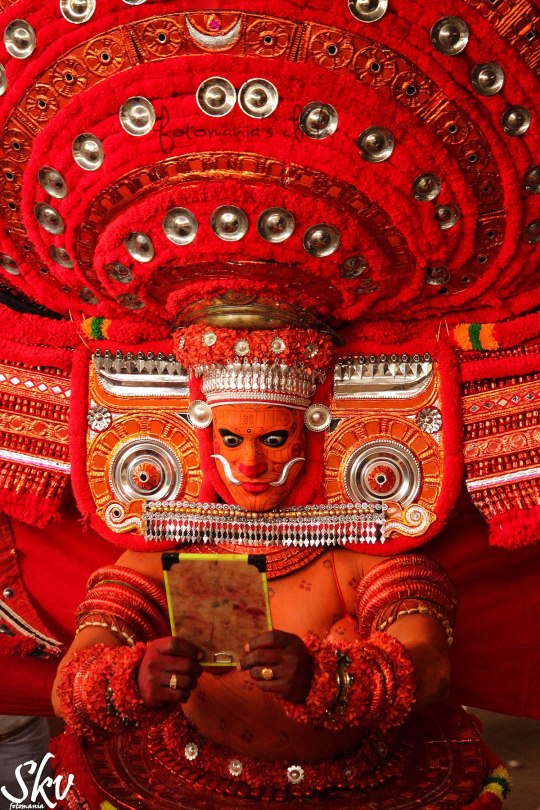
[Puliyoor Kali Theyyam]
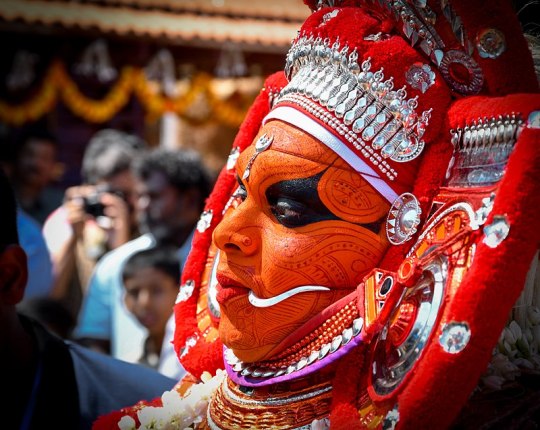
[Porrkali Theyyam]
See that on the cheeks? It resembles Pavitr's design closely right? While Pavitr's are drawn on his mask, these are singular metallic pieces, bound or clutched in the mouth to evoke the imagery and impression of tusks.
Theyyam is not alone in this particular imagery. A variety of folk arts use this, especially animism and folk rituals to show animal physical characteristics, as well as supernatural powers and elements.
For example, below is an image of Thirayttam, a ritual folk practice from the South Malabar region of Kerala. You can see the tusks here too. (Its not that clear, sorry about that.)
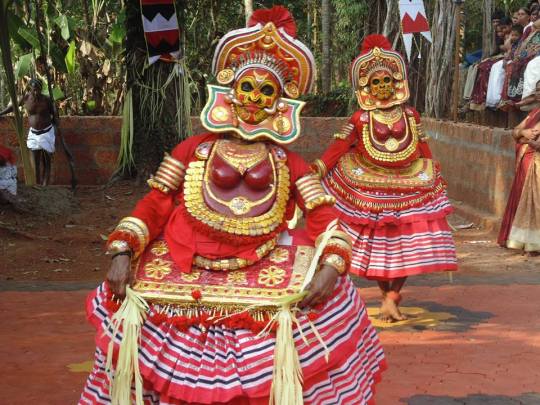
{Reminder: A lot of people think of Theyyam and Thirayattam as the same thing. While there are many similarities, with both being from the Malabar region, they are different practices. Theyyam is also called Tiṟa, and this is the main cause of the confusion but its not Thirayattam.}
Another example is Kalamezhuthu pattu, another religious folk art from Kerala. Mainly associated with the worship of the goddess Badhrakali, it is a sacred floor art done with powder and the result is called a Kalam. Below is a picture of a Kalam.
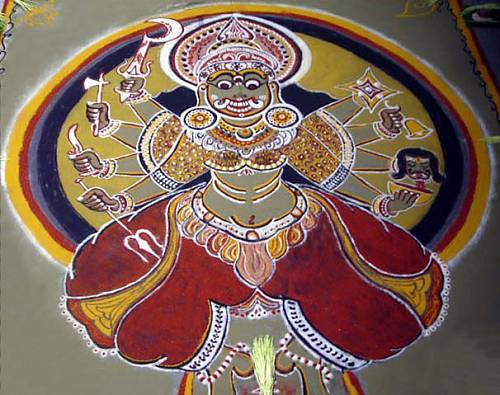
See those tusks? Yeah.
So they represent divinity, animal characteristics, inhuman powers etc.
[Interesting Info: Drawing Kalams are an integral part of Mudiyettu, a traditional ritual theatre and folk dance drama from Central Kerala. It is inscribed in the Representative List of the Intangible Cultural Heritage of Humanity. So do check it out if you're interested.]
{Oh my god I'm going off topic again. Come back bitch.}
To conclude, those lines are inspired by Theyyam markings, and stand for tusks and fangs, and as a spiderperson, who has the powers of a spider, gifted by some spiritual channel, its really apt that he was given such a design.
Next, lets talk about the lower half of Pavitr's mask.
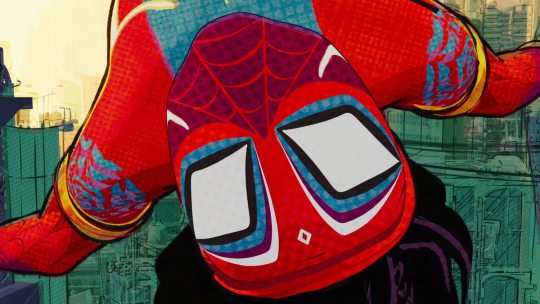
See those delicate red webs underneath the eyes?
This also reminded me of Theyyam. Its overshadowed by the more vibrant aspects of the costume, but a Theyyam's face has these intricate red patterns as well.
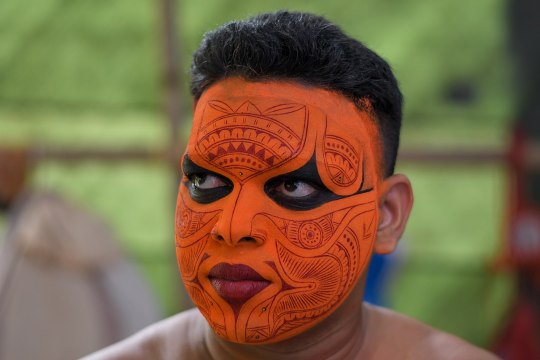
(Look at those eyes, reminds you of Pavitr's eye design right?)
And as you can see in this next image, after the headgear is put on, the designs mainly concentrate on the lower half of the face, much like Pavitr's mask.

I admit I might be stretching this as web designs on the mask is a spiderman thing in general but I think I'm the pretty much on the dot on this one, and most likely its a combination of both.
[A 100% sure about that tusk thing though :)]
Also sometimes Theyyams would have these metallic eye coverings.

[Muchilot Baghavati Theyyam]
A closer look.
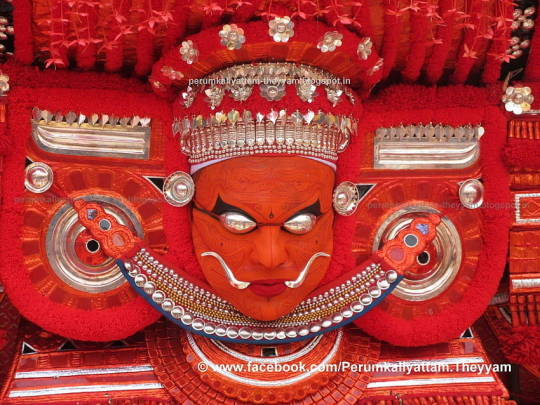
This is just my opinion but those silver eye masks kind of reminded me of the classic Spiderman eyes. Single colour, pupil-less, black outline, no idea how they see out of it etc. This one in particular reminded me of the classic spiderman especially with the eyes outlined in black like that.
Overall, the tusks, plus the thin web design on the mask, and the eyes, the spiderman red colour palette, they all evoked the image of Theyyam for me when I first saw Pavitr on screen.
{There is a very similar art form to Theyyam called Bhootakola in the coastal region of Karnataka, another southern Indian state. Those curious about Theyyam can check out the Kannada movie Kantara which deals with Bhootakola and you'll get an idea about Theyyam as well. The movie is awesome by the way. Watch it if you can.)
(This is getting way too long and image heavy. And I'm also going off tangent too much. Gotta wrap this up!)
Finally lets talk the last aspect of Pavitr's mask. This might actually be the feature that most of the non-Indian audience identified as Indian without anyone pointing it out.
I'm talking about the white, diamond shaped marking on Pavitr's forehead.

This decorative marking, bindi/pottu/tilaku, might actually be the most recognizable aspect of Indian culture across the world.
If you scroll back to all the previous images I provided, you can see some variation of this in all of them, either drawn on, or as an ornament. While there are some cultural differences in how they're worn, like women in southern India wearing them in all stage of life while their northern counterparts wear them only after marriage(I could be wrong about this, as I've seen children wearing them often, and things could've changed in modern times so please do correct me if I'm wrong), its one of the most common motifs you'll see across the country.
It can be a simple, round mark.
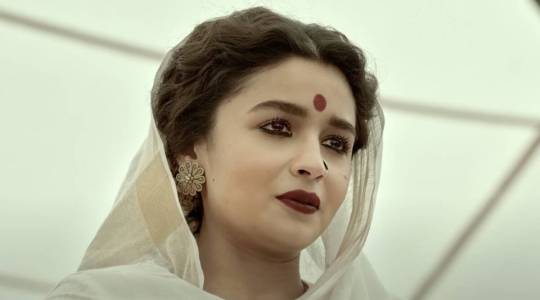
It can be ornamented.
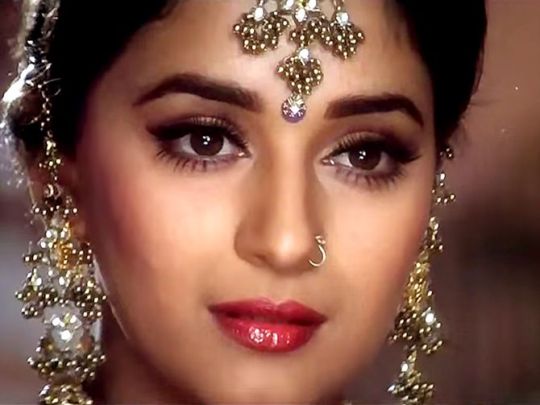
It can be a different shape altogether.
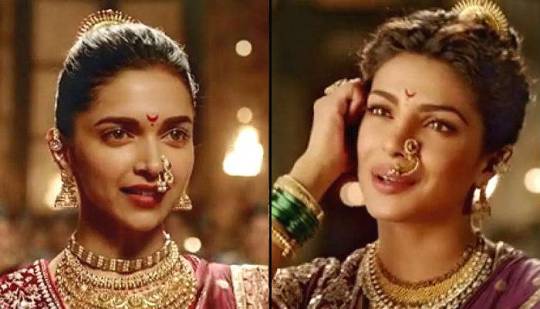
(From the musical sequence 'Pinga' in the Hindi film Bajirao Mastani)
A different colour.
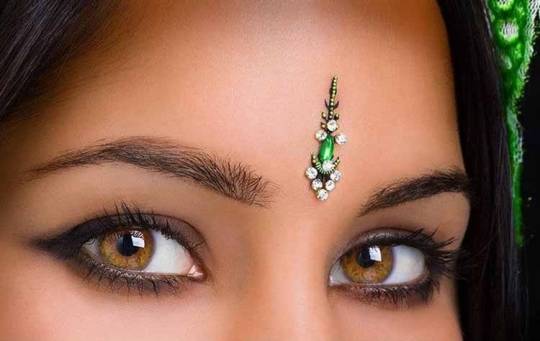
You get the idea.
Men can wear it as well. though styles and decoration maybe different.

(From the Tamizh film Ponniyin Selvan 1)
A more modern version.
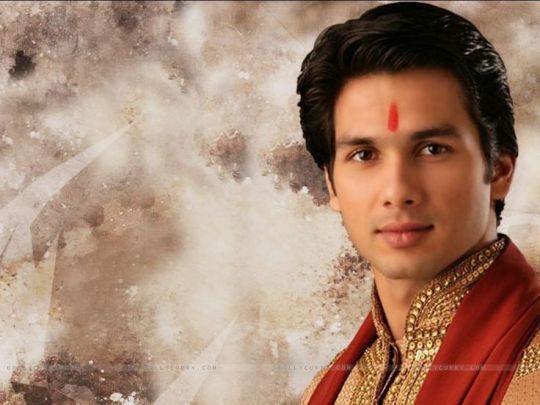
Geography wise, the bindi/pottu/tilak is predominantly seen in India, but its also found in other countries of the Indian subcontinent and neighbouring nations, as well as South-East Asia(as they were both part of the ancient Indosphere and had a past of Hindu Kingdoms. See: Srivijaya(Sriwijaya) empire, Indonesia).
Similar forehead markings were even common in China in the past. Those who have seen wuxia and xianxia dramas and movies definitely have seen them before and know what I'm talking about. (Huadian 花鈿)
Religion wise, its predominantly a Hindu motif, but its also part of Buddhist, Jain, Sikh, as well as several other indigenous religions.
{I've actually seen several Indian Christians and Muslims wear it as well, because its their culture, even if its not their religion.}
EDIT: Gaaaaah! I forgot to include this even though I'd intended to from the beginning.
This is not about the mask but some of the prototype designs for Pavitr so I thought I'll just talk about them a bit here.

Again I can't believe all the effort that went into making this movie. Just look at those designs. Absolutely stellar and inspired. The colour palette itself is amazing.
Honestly everyone else just has no excuse anymore.
[I'll focus on the theatre aspect like I've been doing and talk about the architecture bit sometime else.]
This one is obviously the Theyyam inspired one.

(Look at the eyes of 4 and 3, you can see they're inspired by the silver eye-mask I mentioned before. Also the headband is silver and looks similar to the bands securing a theyyam's headgear in place.)
A lot more Theyyam elements than what made it to the final cut. Especially the jewellery and the sharp-eyed among you must've already noticed the similarity between the necklaces of the design and the necklaces of the theyyams whose images I provided. The bangles and the anklets are also very distinctively Theyyam and they're called Katakam and Chutakam respectively but the final design seems to have made the bangles gold and more bracelet-like, and the anklets more like ankle-cuffs.
(I so badly wish the necklace stayed in but yeah that could've hindered movement.)
Now lets come to the Yakshagana inspired one.
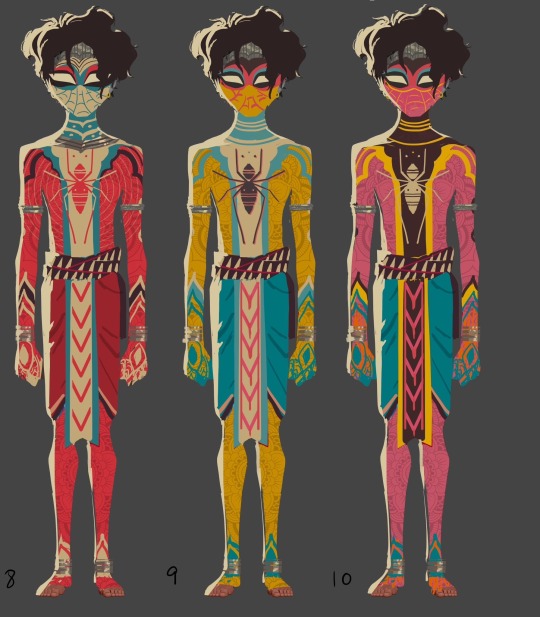
(Notice how the shape of the eyes have changed? And the colour palette took a turn? A lot more gold coming in.)
Yakshagana is a form of traditional theatre originating in modern day Karnataka state of India, and currently practiced in both Karnataka and Kerala. It is primarily an art form from the coastal Karnataka region and the neighbouring Kasargod district of Kerala.
Below is a link to more information on Yakshagana so you can take a look at the costuming and see the influences in the above prototype more clearly.
(I'm not gonna go into detail about all the design choices in the Yakshagana prototype, maybe in another post.)
Now lets come to the final prototype.

(Again the colour palette has shifted, a lot more greens and blues. I do believe that 8 is koothu and not Yakshagana even though it was included in the image above. I say that because of all the white in the design which is very distinctive of a kind of koothu as far as I'm aware.)
I actually already mentioned koothu once before in this post when I was talking about Koodiyattam in the very beginning. So lets go back to it.
Koothu is a folk theatre art that originated in early Tamizh country(Tamizhakam), and broadly speaking, its of two types, Terrukuttu, and Kattaikkuttu. It reached its peak in the golden age of Tamizh culture, the Sangam era and it mainly depicts scene from the epics. Currently types of Koothu are practiced in modern day Tamil Nadu and Kerala(Kerala was once part of ancient Tamizhakam).
Below is a link that will give you more info and an image of the costume with makeup similar to 6.
And this one is a link to a particular kind of koothu in Kerala known as Chakyar Koothu cos all the white on the make of prototype version 8 reminded me of it. (Also Chakyar Koothu is a form of social satire and criticism, it was basically ancient Stand-up comedy and the Chakyar is supposed to be really witty, which fits Spiderman to a T I gotta say.)
Again I'm not gonna go into further details and nuances of the design as this is a prototype design, maybe some other time. But I have to say that this colour palette does make Pavitr a lot more spideresque or evoke a more primal spider energy cos how it connects the viewer to jungle like and more animalistic environments more than the other designs.
And that's it for the mask and the prototypes everybody! Yay!
Holy shit that was long!
I'm gonna stop here for now cos this is already way too much. Can't believe I thought I'd be able to look through the entirety of Pavitr's design in one post. What was I on?
Seriously what kind of drug?
Anyway I'll be making a part 2 for this, looking through Pavitr's clothes and and movements and all. I say Part 2 but considering what happened with the mask I'm pretty sure it might go up to Part 3 or 4. Here's to hoping I learn some moderation by then lol.
(All the images are from google images and I have taken and have credit for exactly none of them. The verbiage is mine completely though.)
#Pavitr Prabhakar#Spiderman India#Indian spiderman#desi spiderman#spiderman atsv#character design#desi design#the desi-gn get it? I'll show myself out#across the spiderverse#spiderman: Into the Spiderverse#Spiderman: Across the Spiderverse#sony spiderverse#atsv#so much love and effort went into this movie and it shows#it was absolutely magnificent#character design inspiration#Indian culture#traditional theatre#traditional artforms#Theyyam#Koodiyattam#Kathakali#Yakshagana#Koothu#Tamil culture#Tamizh culture#Malayali culture#Kannada culture#tulu culture#tuluva culture
75 notes
·
View notes
Text
Vannakam Makkale🪷
I think it's simply marvellous to wake up in a tamillian household.
M.S . Subbulakshmi is the unofficial family member of every house ; her morning subrabatams filling every nook and corner of the house.
And the manjal paste you apply after every bath? A small possible connection with Parvati devi a millenia ago
The warm decoction filter coffee from the two tier coffee filter poured into a steel glass next to a plate of warm and soft iddlie with thengai chutney and karam pudi.
The kolam with an intricate pattern and the poovu in my hair which my amma tucks in with a U pin. The dark green valayal that clink in a melodious rhythm
The simple yet eye-catching pattu saree the ladies wear at temples with matching bottu and jimki kambal. The soft hum of mahishasura mardini chanting. The pongal in tapioca leaf. And that familiar golusu sound of little girls.
The raised eyebrows, the loud and happy voices ,the overly inviting and loving people who love to feed.
I come from the culture of the chozhas and temple bells and tamizh.
Vannakam makkale
🪷🤎✨️🛺🪞✨️🪷🤎✨️🛺🪞✨️🪷🤎✨️🛺🪞

#desi#desi tumblr#my writing#relatable#desi things#southindian#writeblr#indian#tamilian#welcome to south india#vannakam makkale#Nila#tamil girls#temples
8 notes
·
View notes
Text
LITTLE BY LITTLE
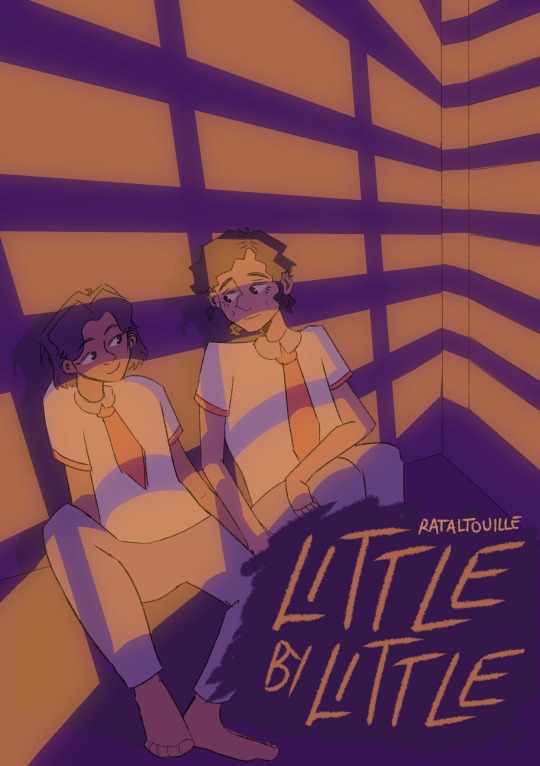

HI IM VERY EXCITED ABOUT THIS SILLY LITTLE STORY. it is:
a feel good lighthearted story about a bunch of kids in high school 👍
one half enemies to lovers romance, other half queerplatonic coming of age 🤨
dual storyline following two annoying siblings who will die for each other 🤱
set in chennai because i want to draw the city i grew up in and have a crisis over not having seen it enough 🤯
me deciding to compensate for my non existent final years of high school via fiction because who needs therapy tbh 🤔
BLURB
It’s Sameera’s last year of high school, and everything’s going her way: she’s a student council head, the captain of the girl’s Kho-Kho team, and she’s liked by almost everyone in her grade. Almost. Frigid, uptight Kayalvizhi, fellow council head, is the lone exception. Their first interaction was a nightmare, and while Sameera is told that Kayalvizhi’s just indifferent to everyone around her, she still feels personally attacked. So when the two of them are paired up as the cultural leaders for their school’s end-of-year ceremony, she’s more than thrilled to prove Kayal wrong by outshining her in everything. Too bad the latter’s determined to shut Sameera up by competing just as fiercely. What neither of them expects, though, is to find common ground, or to realise that the other person isn't who they thought they were, or, god forbid, actually start to enjoy each other’s company.
Anbu is a reserved kid, Sameera’s younger sibling by two years and the apple of every teacher’s eyes. Still just getting used to adolescence, Anbu is, to say the least, a bit disoriented. They’re exploring their confusing world, trying out new hobbies, grappling with their gender identity and pushing the limits of the life they’ve led so far. But right when they think they’ve got it all figured out, change hits them between the eyes in the name of Tamizh—their cool, mysterious neighbour who’s come back from Mumbai years after moving away. Anbu and Tamizh were childhood best friends, but that's childhood, and they know better than anyone else that adolescence upends everything with a rage. As the two’s rekindled friendship begins to deepen, Anbu is left questioning whether they see him as a friend, a crush, or something else entirely.
At least one thing’s certain for them all: this will be an unforgettable year.
CHARACTERS
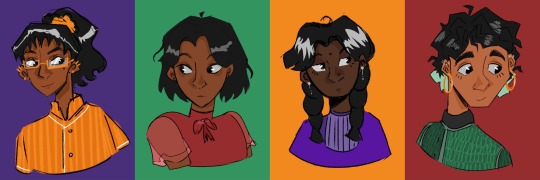
SAMEERA. she/her, bi. annoying ass extroverted jock mf. everyones fave gremlin. needs constant love and validation or else she will perish
ANBU. they/them, trans. former sweetheart now saddled with a growing bloodthirst. going through too much all at once and is on the verge of emotional burnout.
KAYALVIZHI. she/her, trans, lesbian. moody ass introverted nerd mf. hates every single person to ever grace this planet and i love her so much actually
TAMIZH. he/him, aro. Resident Cool Kid™ except he feels very uncool and very unchill, ball of nerves just barely keeping it together. is unlearning a lot of toxic beliefs on gender and he’s doing it with style.
SO WHATS THE DEAL HERE
idk what happened in the last two years but i’ve gone from being a prose hoe to a webcomic bitch and it has been working out great for me. comics are such a brilliant format for someone who’s equal parts artist and writer and recently all my important all-consuming story ideas have been webcomic ideas and im so excited to get to make them!!
there are two parts to this story, two parallel arcs, one for each sibling: sameera’s enemies to lovers story with kayal and anbu’s queerplatonic coming of age thing with tamizh. i think the main inspiration behind this was a) bridgerton season two which was the first time i actually ENJOYED an enemies-to-lovers romance and which made me go hmm yanno what. i’m going to do the same but without british people. b) me realising that as much as i love romance and writing romantic relationships i also would like to write a queerplatonic relationship please and thank you [it is endlessly amusing to me that my favourite genre is romance despite me being aromantic lmao] and i esp wanted to try writing a qpr from the pov of the non-aromantic character, just for that extra spice!
in the very short time ive had these four they’ve taken over my brain completely and i love it so much!! im currently working to on getting the basic prep work done [character turnarounds, uniform designs, bg models etc etc] and i’ll post updates on progress whenever i feel like lmao
#i am unable to end sentences on normal punctuation#a random ass emoji is now my full stop 🥵#i am anbu and kayal on all levels but physical#webcomic#little by little
53 notes
·
View notes
Text
Reading that article now after it being written 2016 is so wild because oh there's so much to follow up and expand one.
Like even with the context then, the discussion of Tamil nationhood and the mass songs without no reference and discussion of Eelam Tamils is WILD. Like was it a word count issue??? I get the average Indian doesn't get or understand Eelam Tamil struggle and context but this was such a contentious issue between dmk and aiadmk and is still brought up within contemporary state political discourse.
Also throw in Seval Kodi and no reference around the understandings and contextualization of Tamil nationhood in Malaysia/Singapore. And author is Singaporean????
But anyways back to the potential follow up article, lol the argument for Tamil turbo folk as a genre post jallikattu protests???? The meta commentary from Tamizh Padams 2 with the Naan Yaarumilla and Evada Unna Petha?
Also the reclamation of gaana in kollywood through pa ranjiths cultural work??? Casteless collective??? Arivu?????? An emerging counter to tamil turbo folk.
#im so zooted right now and can only focus on this article im....in awe#also author lowkey being an anirudh hater sir sollunga your thoughts on arabic kuthu#also waiting for the next nelson anirudh mass song to become full circle and be serbian turbo folk introduced#and its ajith in like 80s military fatigue and amy jackson makes a return as heroine#is this what gets people to make video essays
4 notes
·
View notes
Text
The Emergence of a Diasporic Singular Desi Culture
I have been observing this for a while on several social media platforms and I have a theory that a singular “Desi” culture is taking shape in North America, and perhaps other diasporas. Since I haven’t had much experience with other diasporas in several years, I will only focus on this phenomenon through a North American lense.
The reason for saying is that I increasingly see young South Asians, in particular, Gen Z, make tiktoks mentioning how “our” culture is beautiful, and then proceed to show off cultural dress, cuisine, art, architecture etc. playing to a remixed Bollywood song.
The issue here is not showing appreciation, but the issue is using the singular from of culture instead of the plural — cultures.
South Asia is not a monolith, nor does it have one culture, so which culture in particular are we here appreciating? Every country, whether it would be Pakistan, India, Bangladesh, Nepal, (Southern) Tibet (controversial, I know) , The Maldives, Sri Lanka, Bhutan, and Diaspora countries like Suriname, Guyana, Belize, Trinidad & Tobago, Jamaica, Mauritius, Fiji etc. all have self-contained individual cultures that are inter-connected or unique to their own region.
These tiktoks, from my observation, show only Northern Indian cultural aspects with a heavy emphasis on Punjabi culture. Popular Tiktok dances feature Hindi and Punjabi, yet rarely any music from other states. Then again, it is called fyp for a reason. It may be the content I interact with, but then again I interact with a broad spectrum of self-stylized Desi creators on “brown tiktok”. From North to South.
Every now and then, there is legitimate criticism on limiting Desi tiktok to Hindi-Urdu and Punjabi songs where a number of videos have been circulating to test one’s “Desiness” whether you know these songs or not. Same goes for movies. If not, then you are white-washed. What about the rest, who don’t speak Hindi-Urdu or Punjabi? This is why being “Desi” is quite controversial because it means different things to different people.
Why do I think that there is singular North American Desi culture emerging? It is because Bollywood consumption plays a central role in it in making the younger generation believe that there is a such thing as one culture being portrayed in Bollywood while reality is something very different.
I as a Punjabi am used to seeing my culture being hyper-represented in Indo-Pak media. In fact, it is the culture that is used in Bollywood and Lollywood productions the most when we talk about cultural reprentation. Same for music, apart from Hindi, Punjabi is the only regional language that gets that much attention and gone worldwide – for good and bad reasons.
Home culture is very different. We all have our own home culture that we grew up in. We have our languages, our own foods, our own clothes, own histories, yet when these younger Desis present themselves to the outside world, it all dissipates and changed into this Bollywood-esque performance.
We suddenly ALL eat naan, biryani, samosein, jalebi, gulab jamun, roti and we ALL speak Hindi, wear saris, lehengas, shalwar kameezein and are ALL Indian, desi, and brown.
Yet, here I am, not knowing anything about other regional dishes other than my own which ironically is all of the above and more as a Punjabi-Pakistani. I have no idea what Gujuratis eat, no idea what Sindhis eat, I had no idea what Marathi sounded. I had no idea Bihari songs were popular. I have no idea what Assamese wear.
It disregards everything unique and hyper-focuses on Bollywood and Punjab as the source for this repackaged Desi culture. Bengali home culture, Punjabi home culture, Pashtun home culture, Tamizh home culture, Devehi home culture, Indo-Guyanese home culture, Indo-Surinamese home culture are all different environments, yet you won’t see that when you land on #browntok, instead you will see this generic brand where everyone supposedly can participate in disregarding that it leaves people out and alienizes anyone that doesn’t relate to “Desi culture”
I find it so odd that Patels are quite well represented, yet know nothing about Gujurati culture or their language other than “kemcho”. The reason why I bring this up is because the culture would be seen as foreign to the Desi-sphere and not recognizable as Desi because people views this “Desi culture” though a very narrow lense.
In a way this Desi culture is just repackaged Punjabi culture made palatable for the masses that are fixated on romanticized images of their home countries disregarding class differences, history, and culture. People don’t realize that only certain classe wore such ornamental dresses like the lehenga choli and thatvit was limited to a certain class or money and still is, yet is touted as something accessible to anyone.
Big “Indian” weddings are not the norm, they are the exception, yet still are juxtapositioned with White Weddings as being something extravagent. It only works if you or family have money.
Bottomline: this Desi singular culture does not exist outside of social media realistically because we all have our own cultural aspects that are unique. Bollywood is not an accurate and reliable cultural representation. You are not cultured by watching Bollywood movies, you are a good consumer. People need to show off their regional cultures more.
#pakistani#bangladesh#indian#southasian#brown#Desi#social media#tiktok#bhutan#sri lanka#nepal#the maldives#suriname#guyana#jamaica#indian food
32 notes
·
View notes
Photo
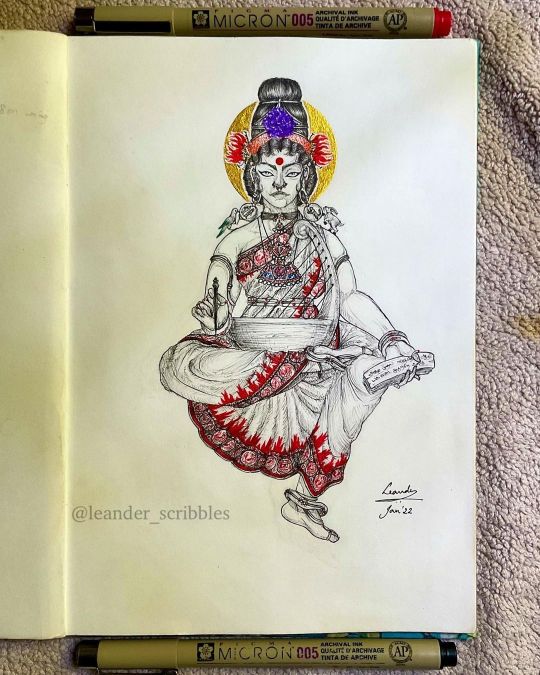
"தமிழ்த்தாய்"/"Thamizhthai" (Mother Tamizh) Today in 1950 India became a Republic, and to commemorate, every year a parade takes place in Delhi, which includes a float from each state showcasing their respective cultures. This year however, the state of Tamil Nadu, along with the other South Indian states (except Karnataka) and West Bengal will not be featured as their floats were rejected. The reason TN was given- the freedom fighters displayed (V.O.C., Veeramangai Velu Nachiyar, Marudhu Pandiyar and Bharathiyar) were not "well known". The sheer audacity and ignorance of the statement makes me gag. But, let’s not go deeper into that. As a civilisation, Tamizhar go back at least 3,200 years, with our language, one of the oldest spoken in the world, at its centre. Our culture and language now is fairly well preserved, though much has been either lost, appropriated or assimilated. Our passion for Tamizh is something I take intense pride in. Nevertheless, unfair power structures have and still continue to exist. Homophobia, transphobia, sexism and casteism continue to run rampant. For a people who claim to be very accepting and inclusive (which we are), when are we going to show the same love to our own? So what can we do? I don't know. I understand that this isn't a very good time, considering everything that's going on, but the fact still remains- we have a lot of work to do. It's long overdue and we need to start NOW. Proper research to educate ourselves on our own culture and history (both the good AND the bad), about how being Tamizh is an ethnicity beyond religion and that Tamizhar are not inherently "Hindus", is essential. Blind fanaticism, disregard for facts and adamance over folk etymology are a huge disservice. We have a long way to go, but we'll get there. Unlearn, relearn, research, reconnect, and contribute. PS- Those responsible for the genocide of Eela Tamizhar and the oppression of Indian Tamizh fisherfolk at the SL-India border are yet to be held accountable. வாழ்க தமிழ். வளர்க தமிழ். #leanderscribbles#tamil#தமிழ்#tamilartist#tamilart#tamilculture#tamilhistory#tamilheritagemonth#eelam#casteism#india#asia#asianart#republicday https://www.instagram.com/p/CZLuIs4BAvE/?igshid=NGJjMDIxMWI=
#leanderscribbles#tamil#தம#tamilartist#tamilart#tamilculture#tamilhistory#tamilheritagemonth#eelam#casteism#india#asia#asianart#republicday
3 notes
·
View notes
Text
"வாழ்க்கையில் வெற்றி பெற வேண்டுமானால் நல்ல நண்பர்கள் தேவை, ஆனால் வாழ்நாள் முழுவதும் வெற்றி பெற வேண்டுமானால் ஒரு எதிரியாவது தேவை. "
- அப்துல் கலாம்
Bangla Translation:
"জীবনে সফল হতে গেলে আপনার ভাল বন্ধু প্রয়োজন, তবে আজীবন সফল হতে গেলে আপনার শত্রু দরকার।"
- আবদুল কালাম
English Translation:
"In order to succeed in life, you need good friends, but in order to succeed for a lifetime, you need an enemy"
- Abdul Kalam
(Thanks to all Tamizh friends for showing support towards the Bangla language. As a token of thanks and appreciation from us Bengalis to all Bengal lovers, I've decided to do these translations from languages other than Bangla.😁✌)
#tamizh#bangla#bong's bongo#tamil#bengali#cultural exchange#love south india#apjabdulkalam#west bengal#tamil nadu#south india#east india#assam#tripura#sri lanka#singapore#bangladesh#translation#bengal#langblr#language#language exchange#abdul kalam#india#president#scientist#friends#enemies#quotes#success
52 notes
·
View notes
Photo

#tamil#tamizh#thamizh#india#sanskrit#history#ancient history#indus valley#harappa#mohenjo daro#pakistan#south asia#religion#culture#style#blue#royal blue#vintage#book#read#civilization#global#yoga#meditation#buddhism#hinduism#ayurveda#siddha
10 notes
·
View notes
Photo
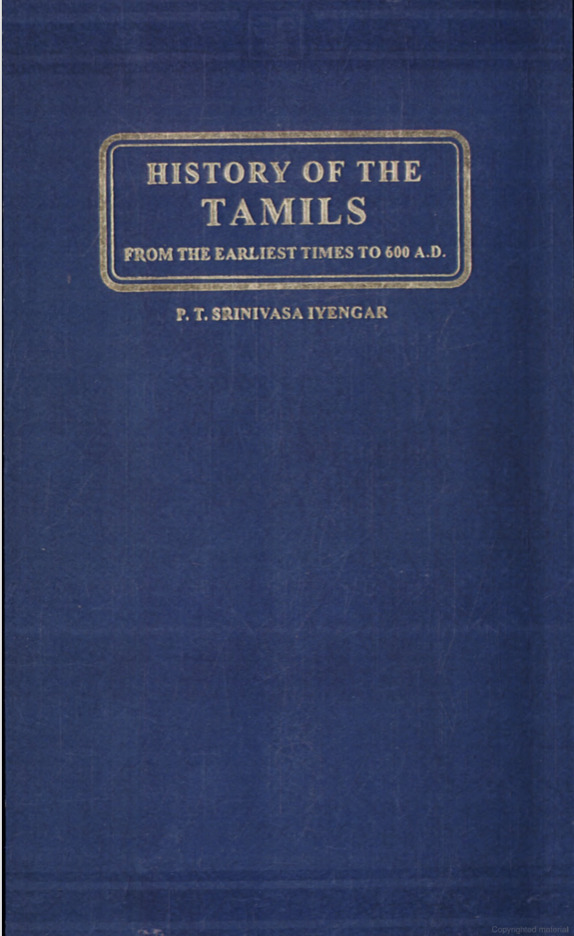
#history#india#tamil#thamizh#tamizh#dravidian#south india#asia#south asia#east#ancient history#culture#book#vintage#blue#royal blue#crimson#genetics#civilization#style#lifestyle#yoga#ayurveda#meditation#buddhism#hinduism
8 notes
·
View notes
Photo

The Traveling Gecko is very happy to bring to you its next musical storytelling tour on Sunday, 2nd February. Led by vocalist Madhuvanthi Badri the tour will take you through the world of Carnatic music, its evolution over the centuries, its traditions, regional influences, and some of its well known and lesser known contributors. The tour will be peppered with lots of songs by Madhuvanthi.
Madhuvanthi Badri is a classical vocalist, teacher, performer and culture host who started training in Carnatic Music when she was 6 years old. She trained under Kalaimamani Vidushi Smt. Bhushany Kalyanaraman, thus imbibing the authentic paatanthara (style) from the GNB and Thanjavur S. Kalyanaraman lineage. She learns advanced music from Kalaimamani Vidushi Smt S. Rajeswari as well. Madhuvanthi is also specially trained in Tamizh music having learnt the Tevaram, Tiruvasagam, Tirumandiram, Periya Puranam, Divya Prabandham and Tiruarutpa from musicologist Dr. Rama. Kausalya, scholar and former principal of the Tiruvaiyaru Music College, with whom she travels to perform lecture demonstrations and conduct workshops.
To register please write to [email protected] or call +91 9940458435.
Date and Time: Sunday, 2nd February, 2020, 7 AM to 9 AM
Meeting Point: West Gopuram (entry tower), Kapaleeswarar Temple, Mylapore
Charges: Rs. 800/- for Adults; Rs. 400/- for children aged 12 yrs and below (payable in advance along with the registration)
Inclusions: Coffee and Taxes
Last date for Registration: 1st February 2020
1 note
·
View note
Text
Coimbatore Vizha event to be held virtual during January 2-10
Coimbatore Vizha event to be held virtual during January 2-10
The 13th edition of Coimbatore Vizha – a celebration of the city’s strength, uniqueness and culture is slated between January 2nd and 10th. And for the first time, the 100-odd events planned across the city over the 10 days are proposed to be held completely virtual, staying mindful of the pandemic.
With the Vizha team reaching out to Tamizh Sangams and Alumni community across the globe, the 2021…
View On WordPress
0 notes
Note
Is keeping your caste name inherently casteist- like in social media because then what if someone is just trying to obfuscate their caste privilege
Sinthujan Varatharaja @/varathas on instagram has a highlight reel, tamil surnames, that does a good job of summarizing why tamil culture has now adopted the naming system it does and what it means to how we relate to each other and as part of a legacy of a struggle for caste annihilation
cause who is keeping caste names? Dalit Bahujan people or is it the iyers, chettys etc. there will always be people who are privileged, who will in spaces try to hide their identity and also leverage insitutions and systems of power for their own benefit through identity(as it relates to caste, also race) so while it is annoying that privileged folks will deflect accountability and ownership of their position, i dont think in the overall scheme of things outweighs the benefits of not having name based caste identifiers.
what is important is how are we leading and walking towards paths of living as casteless tamizhs ( in the words of Pandit Iyothee Thaassar) we have to believe and imagine this world and in our lives work to make it a reality, including changing our cultural practices and redefining what it means to be a Tamil rooted in tamil identity not caste identity and what it means to be accountable to that. this also includes structural and material changes.
1 note
·
View note
Photo
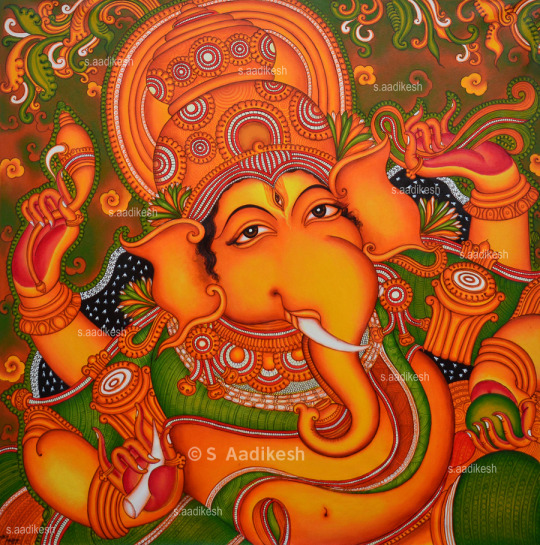

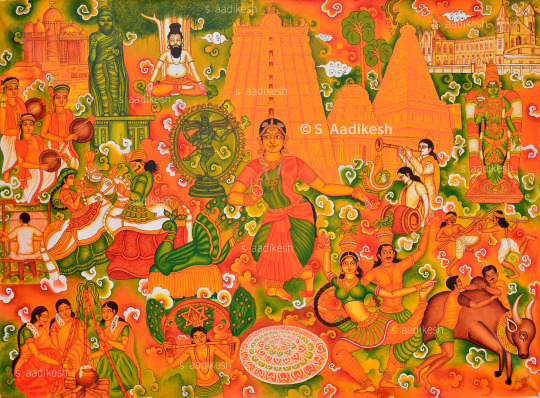
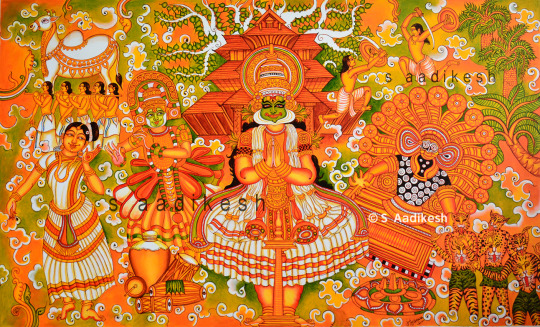
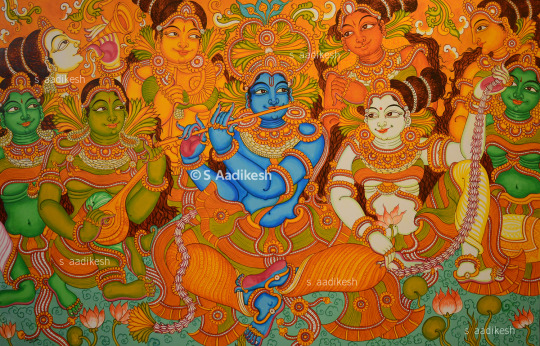
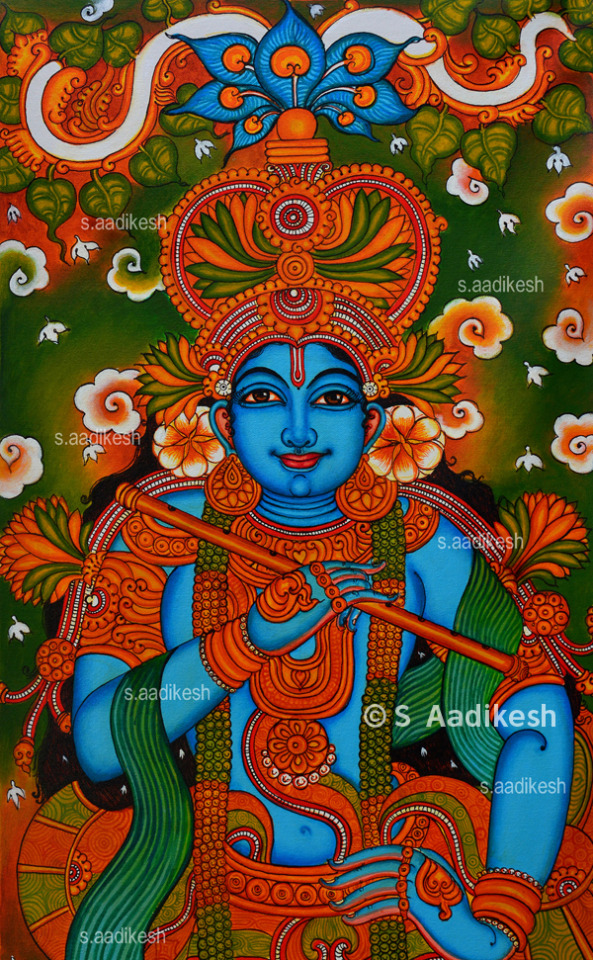


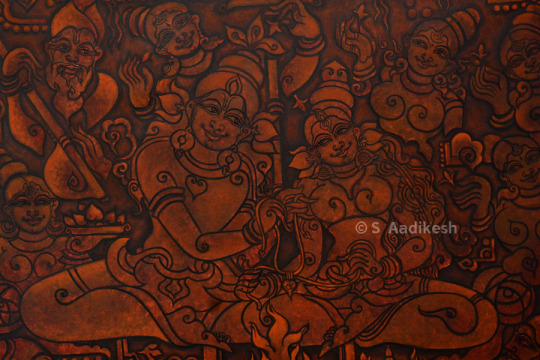

I’m S. Aadikesh independent artist from kerala, india. My works is inspired by Indian mythology, epics, culture, murals and spirituality. I love to constantly experiment with new things in painting. Mobile +91 9496340648 +91 8129335435 | Email : [email protected]



#s-aadikesh-art#s-aadikesh-painting#s-aadikesh-paintings#s-aadikesh-drawing#s-aadikesh-drawings#s-aadikesh#s-aadikesh-illustration#s-aadikesh-artist#s-aadikesh-artists#s-aadikesh-kollengode#s-aadikesh-kollengode-artist#s-aadikesh-palakkad#s-aadikesh-kerala-artist#s-aadikesh-indian-artist#s-aadikesh-mural-artist#s-aadikesh-spiritual-artist#s-aadikesh-spiritual-painters#s-aadikesh-devotional-artist#s-aadikesh-divine-painter#s-aadikesh-kerala-mural-painting-artist#kerala#kerala-mural-painting#kerala-mural-art#mural-paintings#mural-art#mural-drawings#keralamural#aadikesh-kerala-mural#indian-murals#indian-mural
0 notes
Photo
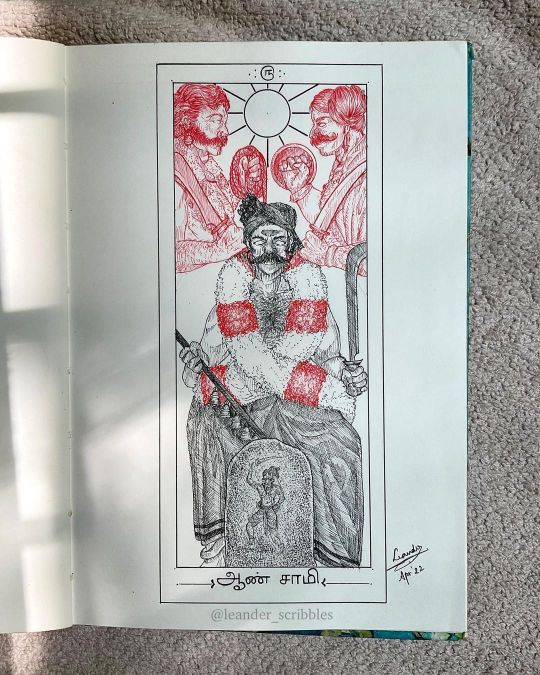
"ஆண் சாமி"/"Aan Sāmi" (The Hierophant) This next installment, The Hierophant, features a male சாமியாடி (deity-dancer), [also known as a சாமி (deity)], and a நடுக்கல் (hero-stone). There is no regular clergical order in Dravidian folk religion, which operated on fear and necessity, rather than devotion and ritual. சாமியாட்டம்/வெறியாட்டம் can often be seen at rural temple festivals. These dancers act as spirit conduits after going into a trance. They answer queries, deliver verdicts, diagnose diseases and curses among others. The spirits in question are of deified ancestors or independent deities of indigenous folk origins. These deities were later assimilated into mainstream Hinduism with sthalapurānas that were written in a way that subdued them and, by extension, the people who worshipped them. This led to their subjugation under the caste system and the invasion of folk Dravidian spiritual spaces by Vedic clergy. The gods (in red) featured here are மதுரை வீரன் (Madurai Veeran) and முனியாண்டி (Muniyandi). There are many others. The tamizh word for celebration (கொண்டாட்டம்) may have its roots in this tradition: கொள்ளுதல் (to take in/receive) + ஆடுதல் (to dance) = கொண்டாடுதல் = கொண்டாட்டம். Like Theyyam from Kerala and Bhootha from Karnataka, similar cultures exist across South India. The tradition of நடுக்கல் வழிபாடு (Hero-Stone Worship) also continues to exist. Hero stones are dedicated to fallen warriors and other people who served the community. Many hero-stones, displaying impressive detail for their age, still survive. The next installment will be a continuation. I've planned for this card and the next to be twin cards of sorts. If you wish to dive deeper into the history of Dravidian folk spirituality, @whatthepottu 's page would be a good place to start. Sources: Xavier, S. Sanskritisation Of The Deities Of Folk Tradition And Hindu Revivalism In Tamil Nadu. 2007. #leanderscribbles#tamil#tamilartist#tamilart#lineart#art#indigenous#southindian#indian#asian#tarot#tarotart#divination#occult#spirituality https://www.instagram.com/p/CcKOJikLVrK/?igshid=NGJjMDIxMWI=
#leanderscribbles#tamil#tamilartist#tamilart#lineart#art#indigenous#southindian#indian#asian#tarot#tarotart#divination#occult#spirituality
3 notes
·
View notes
Photo

YouTube Link: https://youtu.be/Uz776_QIRUU 👆Check the link in profile bio👆 The identity of any culture doesn’t rest on the similarity between the lifestyle of the current generation and their descendants but it lies in the continuity of the traditions. Sense of continuity over the centuries and remembrance of the past by practicing it are what cultural identity is all about, and we are not ready to lose it. #AmendPCA #SaveJallikattu #DissolveAWBI #Tamizh #Tamil #Culture
0 notes